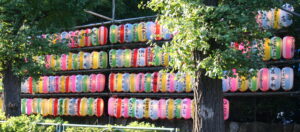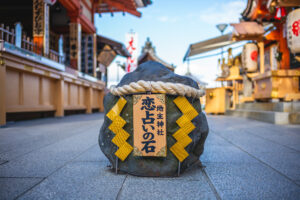In an increasingly chaotic world, the search for tranquility has led many to explore the meditative beauty of Zen rocks. These natural elements, often arranged in serene patterns, not only enhance the aesthetics of a garden but also foster mindfulness and relaxation. This article will delve into the various aspects of Zen rock gardens, from their historical significance to their therapeutic benefits, offering insights into how these tranquil landscapes can transform our environments and our minds.
The Allure of Zen Rocks: Nature’s Meditative Beauty
The simple yet profound beauty of Zen rocks captivates those who encounter them. Unlike traditional gardens that may burst with color and life, Zen rock gardens employ minimalism, steering attention to the natural forms and textures of rocks. This aesthetic invites quiet reflection, making it a perfect backdrop for meditation and contemplation. The arrangement of stones against raked gravel or sand creates a sense of balance and harmony, drawing the eye and calming the spirit.
Moreover, the tactile experience of walking among carefully placed stones can be grounding, reminding individuals of the natural world. Each rock tells a story, representing natural forces that shaped it over years, encouraging visitors to ponder their own place within the greater context of nature. The allure of Zen rocks lies not just in their appearance, but in their ability to evoke feelings of serenity.
Environmental factors also play a significant role in enhancing the beauty of Zen gardens. Sunlight, shadows, and seasonal changes constantly alter the visual experience, bringing new life to the rocks with each passing day. This dynamic relationship between light and landscape encourages a deeper connection with nature, reinforcing the notion that beauty is often found in simplicity.
Zen rocks also invite creativity. While traditional arrangements follow age-old principles, visitors and gardeners are encouraged to express their personal aesthetics through their designs. This balance of tradition and individual expression fosters a deep appreciation for both the art form and the natural materials involved, making each Zen garden unique.
The allure of Zen rocks goes beyond mere appearances. The experience of engaging with them offers a momentary escape from the frenetic pace of modern life. By immersing oneself in the tranquility of these carefully curated landscapes, individuals can rediscover a sense of peace that often eludes them in daily routines.
Ultimately, the allure of Zen rocks lies in their ability to connect people with nature and themselves. This connection cultivates a mindful presence that encourages individuals to slow down, breathe, and appreciate the beauty surrounding them.
Understanding the History of Zen Rock Gardens
Zen rock gardens, or “karesansui”, have a rich history that dates back to the 6th century, emerging during the Heian period in Japan. Originally influenced by Chinese landscape painting, these gardens evolved as a response to the Zen Buddhist philosophy that emphasized simplicity and introspection. The aesthetic principles of Zen, which prioritize mindfulness and meditation, naturally aligned with the creation of these tranquil spaces.
The earliest Zen rock gardens were designed in temple settings, where monks could retreat and meditate. The careful arrangement of rocks and gravel symbolized natural landscapes, allowing practitioners to connect with the world outside while remaining in a controlled environment. These gardens served not only as places for meditation but also as visual representations of Zen teachings.
As time progressed, the art of Zen gardening spread across Japan. Each region developed its own style and characteristics, influenced by local geography, climate, and cultural practices. Notable Zen gardens, such as those in Ryoan-ji and Daisen-in, became celebrated for their masterful compositions and profound meanings. These sites are now recognized as UNESCO World Heritage sites, attracting visitors worldwide who seek inspiration and peace.
The Edo period marked a significant transformation in the design of Zen gardens, as they became more accessible to the general public. The aesthetic shifted to include various forms of artistry, blending traditional elements with innovative designs. This era saw the proliferation of tea gardens, which combined the principles of Zen with the rituals of tea preparation, creating spaces that were designed for both beauty and function.
Today, Zen rock gardens continue to embody the essence of Japanese culture and spirituality. They are not merely relics of history; rather, they are living art forms that adapt to contemporary interpretations while retaining their original purpose of fostering mindfulness and tranquility.
Understanding the rich history of Zen rock gardens allows individuals to appreciate their significance on a deeper level. The connection to Zen Buddhism infuses these spaces with a sense of purpose, transforming simple rocks into profound symbols of peace.
How Zen Rocks Promote Mindfulness and Relaxation
Zen rocks are intentional in their design, reflecting the principles of mindfulness that are central to Zen Buddhism. Mindfulness, the practice of being present and fully engaged with the moment, is cultivated through the experience of being in a Zen garden. The act of observing the arrangement of rocks and the patterns in the gravel encourages individuals to slow down and engage their senses, leading to a more profound awareness of their surroundings.
When one enters a Zen garden, the mind naturally shifts focus from the distractions of daily life to the details of the landscape. The textures of the rocks, the soft whisper of gravel beneath one’s feet, and the gentle rustling of leaves all converge to create a sensory experience that fosters relaxation. This immersive environment enables individuals to leave behind stress and anxiety, embracing a state of calm.
Research indicates that spending time in nature has significant psychological benefits, including reduced stress levels and improved mood. Zen gardens, with their focus on natural elements, enhance these effects. The simple act of strolling through a Zen rock garden can lead to a meditative state, where thoughts settle and clarity emerges. This connection to nature encourages a sense of belonging and grounding, which is essential for mental well-being.
Mindfulness practices, such as meditation or deep breathing, can be easily integrated into time spent in a Zen garden. As individuals engage with their surroundings, they can utilize the space to cultivate a deeper sense of self-awareness. The garden’s tranquility serves as a perfect backdrop for introspection, allowing for a clearer understanding of personal thoughts and emotions.
Zen gardens also offer a respite from technology, which often bombards individuals with stimuli and distractions. By stepping into a Zen landscape, one can disconnect from devices and reconnect with the natural world. This digital detox contributes to an overall sense of peace, facilitating a return to a more mindful, present state of being.
Ultimately, Zen rocks and their gardens serve as powerful tools for promoting mindfulness and relaxation. They remind us of the importance of slowing down and appreciating the beauty in simplicity, allowing for moments of reflection and serenity in our busy lives.
The Art of Arranging: Techniques for Zen Gardens
Creating a Zen rock garden is both an art and a practice grounded in careful consideration and intention. The arrangement of rocks and gravel requires a thoughtful approach, as each element plays a significant role in the overall design and experience of the garden. To master this art, one must understand the principles guiding the arrangement, including balance, harmony, and symbolism.
The first step in arranging a Zen garden is selecting the right stones. The size, shape, and texture of each rock influence the composition and meaning of the space. Larger boulders may represent mountains, while smaller stones can symbolize rivers or islands. The juxtaposition of different rock sizes creates visual interest and encourages the eye to wander through the landscape.
Once the stones are chosen, the placement process begins. This requires a keen eye for balance and proportion. Asymmetry is a fundamental principle in Zen gardens, where uneven arrangements often evoke a sense of natural beauty. Gardeners are encouraged to create focal points with larger rocks while scattering smaller stones around them, establishing a flow that guides viewers through the space.
The use of gravel or sand is equally important in the arrangement of a Zen garden. Raked patterns in the gravel symbolize waves or ripples in water, adding movement and dynamism to the otherwise still landscape. The act of raking itself can be meditative, providing an opportunity to connect with the garden on a deeper level. Each stroke of the rake invites mindfulness and attention to the moment.
Textures, colors, and contrasts also play a vital role in the aesthetic appeal of Zen gardens. The smooth surface of rocks juxtaposed with the soft, fine grains of gravel creates a harmonious dialogue between the elements. Gardeners often experiment with varying shades of gravel, allowing for subtle variations in tone that enhance the overall composition.
Ultimately, the art of arranging Zen rocks requires patience, practice, and an appreciation for the natural world. Through careful consideration and intention, individuals can create spaces that not only reflect their personal aesthetics but also foster mindfulness and tranquility in their lives.
Key Elements That Define a Zen Rock Landscape
Zen rock gardens are characterized by several key elements that work together to create a serene and harmonious atmosphere. Understanding these components can help individuals appreciate the artistry behind their design and the deeper meanings they convey.
One of the most prominent features of a Zen garden is, of course, the rocks themselves. They serve as the foundational elements, representing mountains, islands, or other natural formations. Each rock’s placement is intentional, often symbolizing specific concepts from Zen philosophy. For example, a single, prominent stone might symbolize strength, while several smaller stones may represent a flowing river.
Gravel or sand is another essential element in Zen gardens. Raked to create patterns that suggest water ripples or waves, this material adds movement to the otherwise still landscape. The act of raking the gravel can be a meditative practice in itself, offering a tactile experience that enhances the connection to the garden. The texture of the gravel contrasts with the smooth surfaces of the rocks, creating a dynamic visual landscape.
Plants, though often minimal in Zen gardens, play a significant role as well. Carefully selected greenery, such as moss, dwarf trees, or shrubs, can enhance the overall aesthetic without overwhelming the simplicity of the design. The inclusion of plants adds life and color to the garden, providing a reminder of nature’s vitality amidst the stone and gravel.
Another defining element is the use of pathways, which guide visitors through the garden and encourage exploration. These paths may be formed from stepping stones, gravel, or even wood, creating a journey that invites reflection and contemplation. The design of pathways emphasizes the balance between the natural and the cultivated, reinforcing the connection between the viewer and the landscape.
Water features, although less common, can also be incorporated into Zen gardens, representing the flow of life and the passage of time. A small pond or a trickling stream can enhance the sensory experience of the garden, offering the calming sound of water to complement the visual elements.
By understanding these key components, individuals can gain a greater appreciation for the beauty and meaning within Zen rock gardens. Each element contributes to a cohesive and tranquil landscape, inviting visitors to pause, reflect, and find peace within themselves.
The Connection Between Zen Rocks and Japanese Culture
The relationship between Zen rocks and Japanese culture is deeply intertwined, reflecting the values, aesthetics, and philosophies that define the nation. Rooted in the teachings of Zen Buddhism, these gardens offer a space for meditation and introspection, embodying the principles of simplicity and beauty that are central to Japanese art forms.
Japan’s connection to nature is evident in its cultural practices, where landscapes are not merely seen but experienced. Zen gardens, with their minimalist design, reflect this appreciation for nature’s beauty while emphasizing the importance of harmony and balance. The arrangement of stones and gravel aligns with the Japanese worldview, which sees nature as a reflection of the human experience.
Additionally, the concept of “wabi-sabi,” which celebrates imperfection and the transient nature of life, resonates deeply within Zen rock gardens. The irregular shapes of rocks, combined with the natural wear of time, embody the essence of wabi-sabi, inviting individuals to embrace the beauty of imperfection. This perspective encourages a greater understanding of life’s fleeting moments, fostering a sense of acceptance and appreciation for the present.
Cultural practices such as tea ceremonies often incorporate elements of Zen gardens, creating a seamless connection between art, spirituality, and daily life. The tranquil settings of Zen gardens serve as ideal environments for these rituals, where mindfulness and intentionality are paramount. The presence of rocks and carefully arranged landscapes enhances the experience, reinforcing the importance of nature in Japanese culture.
Moreover, the aesthetic principles found in Zen gardens influence various art forms, including painting, poetry, and architecture. The simplicity and elegance of Zen design can be seen in traditional Japanese art, where the philosophy of minimalism encourages artists to distill their work to its essence. This cultural appreciation for simplicity is reflected in the beauty of Zen gardens, reinforcing their significance in Japanese identity.
Ultimately, the connection between Zen rocks and Japanese culture is profound and multifaceted. These gardens serve as a testament to the values of mindfulness, simplicity, and harmony that permeate the cultural landscape of Japan, inviting individuals to explore their own relationship with nature and self.
Exploring Famous Zen Rock Gardens Around the World
Zen rock gardens have transcended their Japanese origins, inspiring landscapes around the globe that embody the principles of tranquility and mindfulness. While Japan hosts some of the most renowned examples, various gardens worldwide have embraced the Zen aesthetic, each interpreting the style according to local culture and environment.
One of the most famous Zen gardens is Ryoan-ji in Kyoto, Japan. This UNESCO World Heritage site features a minimalist layout of 15 rocks placed upon a bed of white gravel. The arrangement is designed to evoke contemplation and meditation, enticing visitors to explore their feelings and thoughts as they observe the garden’s simplicity. The beauty of Ryoan-ji lies in its ambiguity; the meaning of the rock placement is open to interpretation, allowing for personal reflection.
Another significant Zen garden is the Daisen-in temple garden, located within the Daitoku-ji complex in Kyoto. This garden is celebrated for its intricate design, which combines rocks, water features, and carefully chosen plants to create a harmonious landscape. The layout is intended to reflect the essence of nature, providing visitors with an immersive experience that fosters mindfulness and tranquility.
In the United States, the Portland Japanese Garden stands as an embodiment of Zen principles, showcasing a variety of traditional Japanese garden styles, including a stunning rock garden. The garden features a carefully curated selection of rocks, paths, and water elements that invite contemplation and connection with nature. This garden serves as a cultural bridge, allowing visitors to experience the beauty of Zen gardening while promoting cross-cultural understanding.
Moving beyond Japan and the United States, the Zen garden at the St. Louis Art Museum offers a unique interpretation of Zen aesthetics. This landscape incorporates local materials and flora, emphasizing the connection between the garden and its surroundings. The design encourages visitors to engage with both art and nature, fostering a sense of community and mindfulness.
In Europe, the Zen garden at the Rosenthaler Platz in Berlin, Germany, is a contemporary example of Zen principles integrated into urban life. This small yet impactful space features rocks, gravel, and minimal vegetation, creating a tranquil oasis within the bustling city. The garden offers residents and visitors alike a space to find peace and reflection amid the chaos of daily life.
Exploring these famous Zen rock gardens around the world reveals a shared appreciation for tranquility and mindfulness that transcends cultural boundaries. Each garden, while unique in its design, embodies the same fundamental principles that make Zen gardens a cherished element of human experience.
The Therapeutic Benefits of Creating Zen Gardens
The act of creating a Zen garden offers numerous therapeutic benefits that extend beyond the physical landscape. Engaging in this mindful practice can lead to increased well-being, reduced stress, and a deeper sense of connection to oneself and the natural world.
One of the primary benefits of crafting a Zen garden is the opportunity for mindfulness. The process of selecting stones, arranging gravel, and designing the landscape encourages individuals to focus on the present moment. This intentional engagement allows for a meditative experience, where thoughts can settle, and clarity can emerge.
Gardening, in general, has been shown to have positive effects on mental health. The physical activity involved in creating a Zen garden releases endorphins, promoting a sense of happiness and well-being. Additionally, spending time outdoors and connecting with nature has been linked to reduced levels of anxiety and depression.
Furthermore, the practice of raking gravel or sand in a Zen garden can be incredibly therapeutic. The repetitive motion can serve as a form of active meditation, helping individuals to clear their minds and find a sense of calm. The tactile experience of working with the materials fosters a deeper connection to the garden, reinforcing the therapeutic effects of the activity.
Creating a Zen garden also offers a creative outlet for self-expression. Individuals can personalize their designs, choosing elements that resonate with their aesthetics and values. This creative process can enhance feelings of accomplishment and satisfaction, contributing to overall mental well-being.
Ultimately, the therapeutic benefits of creating Zen gardens extend far beyond the physical landscape. Through mindfulness, physical activity, and self-expression, individuals can cultivate a sense of peace and connection that positively impacts their mental and emotional health.
Tools and Materials for Crafting Zen Rock Designs
Creating a Zen rock garden requires specific tools and materials that facilitate the arrangement of rocks, gravel, and plants. Understanding these essentials can help individuals embark on their journey of crafting tranquil landscapes infused with mindfulness.
At the core of any Zen garden is the gravel or sand, which serves as the foundation for the design. Selecting the right type of gravel is essential; finer materials create a smoother surface and allow for intricate raking patterns. Coarser gravel, on the other hand, can add texture and contrast to the landscape.
Rakes are indispensable tools in Zen gardening, used to create patterns in the gravel or sand. Traditional Japanese rakes, known as “kake,” feature a long handle and a wide, flat head, allowing for smooth, sweeping motions. Smaller rakes can be employed for detailed work, enabling the gardener to craft delicate designs that evoke water ripples or waves.
Selecting the right rocks is crucial for establishing the visual theme of the Zen garden. Stones should be chosen based on their size, shape, and texture. Larger boulders can serve as focal points, while smaller stones can be used to create pathways or borders. The natural characteristics of the rocks contribute to the overall harmony of the design.
Incorporating plants into the Zen garden can enhance its beauty and serenity. Choosing low-maintenance greenery, such as moss, shrubs, or dwarf trees, can complement the rocks without overpowering the minimalist design. Tools for planting, such as trowels and pruning shears, are essential for maintaining the garden’s aesthetics.
Additional materials, such as landscape fabric, can be used to suppress weeds and maintain the integrity of the gravel surface. Adding water features, like small ponds or fountains, may require pumps and plumbing materials, creating a connection to the element of water, which symbolizes tranquility in Zen gardens.
Ultimately, the right tools and materials empower individuals to craft their Zen rock gardens with intention and creativity. By thoughtfully selecting elements that resonate with their vision, gardeners can create serene spaces that promote mindfulness and connection to nature.
The Role of Nature in Enhancing Zen Experiences
Nature plays a pivotal role in enhancing the experience of Zen rock gardens, providing a backdrop that fosters tranquility and mindfulness. The interaction between the natural environment and the carefully curated elements of a Zen garden creates a harmonious space where individuals can reconnect with themselves and their surroundings.
The presence of natural elements, such as rocks, gravel, and vegetation, invites individuals to engage with the world in a deeper way. The tactile experience of walking on gravel or touching the smooth surfaces of stones encourages mindfulness and presence, allowing individuals to become attuned to their surroundings. This connection to nature facilitates a sense of grounding and peace, essential for meditation and introspection.
The changing seasons further enhance the Zen experience, offering a dynamic landscape that reflects the cycle of life. Spring blossoms, summer greenery, autumn leaves, and winter snow all contribute to the garden’s visual narrative. These seasonal transitions remind individuals of the impermanence of life, a core tenet of Zen philosophy. Observing these changes can evoke feelings of gratitude and appreciation for the present moment.
Sound is another natural element that enhances Zen experiences. The gentle rustling of leaves, the soft chirping of birds, and the soothing sound of water flowing can create a meditative atmosphere. These auditory experiences encourage individuals to immerse








